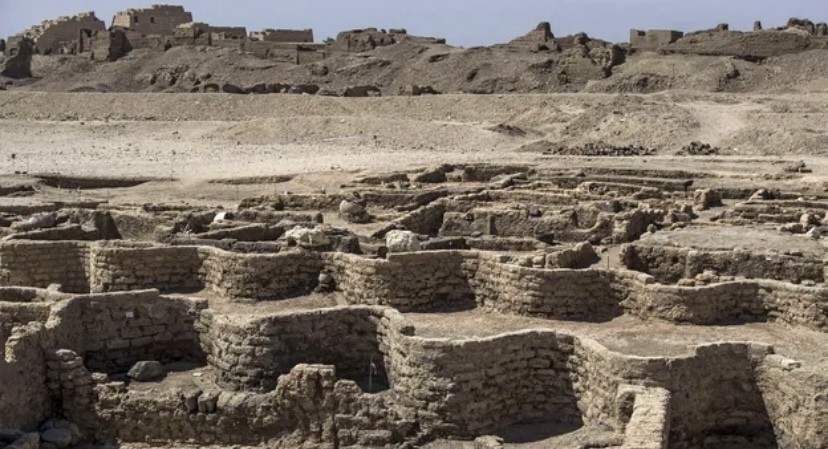
3,000-year-old ‘lost golden city’ of ancient Egypt discovered
Archaeologists have hailed the discovery of what is believed to be the largest ancient city found in Egypt, buried under sand for millennia, which experts said was one of the most important finds since the unearthing of Tutankhamun’s tomb.
The famed Egyptologist Zahi Hawass announced the discovery of the “lost golden city”, saying the site was uncovered near Luxor, home of the Valley of the Kings.
“The Egyptian mission under Dr Zahi Hawass found the city that was lost under the sands,” the archeology team said. “The city is 3,000 years old, dates to the reign of Amenhotep III, and continued to be used by Tutankhamun and Ay.”
It called the find the largest ancient city, known as Aten, ever uncovered in Egypt.
Betsy Bryan, Professor of Egyptian art and archaeology at Johns Hopkins University, said the find was the “second most important archeological discovery since the tomb of Tutankhamun”, according to the team’s statement.
Items of jewellery such as rings have been unearthed, along with coloured pottery vessels, scarab beetle amulets and mud bricks bearing the seals of Amenhotep III.
Hawass, a former antiquities minister, said: “Many foreign missions searched for this city and never found it.”
 A skeletal human remain is seen near Luxor, Egypt. Photograph: Zahi Hawass Center for Egyptolog/Reuters
A skeletal human remain is seen near Luxor, Egypt. Photograph: Zahi Hawass Center for Egyptolog/Reuters
The team began excavations in September 2020, between the temples of Ramses III and Amenhotep III near Luxor, 500km (300 miles) south of the capital, Cairo.
“Within weeks, to the team’s great surprise, formations of mud bricks began to appear in all directions,” the statement read. “What they unearthed was the site of a large city in a good condition of preservation, with almost complete walls, and with rooms filled with tools of daily life.”
After seven months of excavations, several neighbourhoods have been uncovered, including a bakery complete with ovens and storage pottery, as well as administrative and residential districts.
Amenhotep III inherited an empire that stretched from the Euphrates to Sudan, archaeologists say, and died around 1354 BC.
He ruled for nearly four decades, a reign known for its opulence and the grandeur of its monuments, including the Colossi of Memnon – two massive stone statues near Luxor that represent him and his wife.
“The archaeological layers have laid untouched for thousands of years, left by the ancient residents as if it were yesterday,” the team’s statement said.
Bryan said the city “will give us a rare glimpse into the life of the Ancient Egyptians at the time where the empire was at his wealthiest”.
 Egyptologists said they found ‘rooms filled with tools of daily life’.Photograph: Zahi Hawass Center for Egyptolog/Reuters
Egyptologists said they found ‘rooms filled with tools of daily life’.Photograph: Zahi Hawass Center for Egyptolog/Reuters
The team said it was optimistic that further important finds would be revealed, noting it had discovered groups of tombs it reached through “stairs carved into the rock”, a similar construction to those found in the Valley of the Kings.
“The mission expects to uncover untouched tombs filled with treasures,” the statement added.
After years of political instability linked to a popular revolt in 2011, which dealt a severe blow to Egypt’s key tourism sector, the country is seeking to bring back visitors, in particular by promoting its ancient heritage.
Last week, Egypt transported the mummified remains of 18 ancient kings and four queens across Cairo from the Egyptian Museum to the new National Museum of Egyptian Civilisation, a procession dubbed the “Pharaohs’ Golden Parade”.
Among the 22 bodies were those of Amenhotep III and his wife Queen Tiye.
As 2022 begins, there’s a new year resolution we’d like you to consider. We’d like to invite you to join more than 1.5 million people in 180 countries who have taken the step to support us financially – keeping us open to all, and fiercely independent.
In 2021, this support sustained investigative work into offshore wealth, spyware, sexual harassment, labour abuse, environmental plunder, crony coronavirus contracts, and Big Tech. It enabled diligent, fact-checked, authoritative journalism to thrive in an era of falsehood, sensation, hype and breathtaking misinformation and misconception.
In 2022, we’ll be no less active, with a cluster of elections (France, Brazil, the US to say the least), economic pinch points, the next phase of the pandemic, the gathering climate emergency and the first ‘winter World Cup’ to keep us busy.
With no shareholders or billionaire owner, we can set our own agenda and provide trustworthy journalism that’s free from commercial and political influence, offering a counterweight to the spread of misinformation. When it’s never mattered more, we can investigate and challenge without fear or favour.
Unlike many others, Guardian journalism is available for everyone to read, regardless of what they can afford to pay. We do this because we believe in information equality. While others commoditise information, we seek to democratise it. Greater numbers of people can keep track of global events, understand their impact, and become inspired to take meaningful action.
If there were ever a time to join us, it is now. Every contribution, however big or small, powers our journalism and sustains our future.
source: theguardian.com
